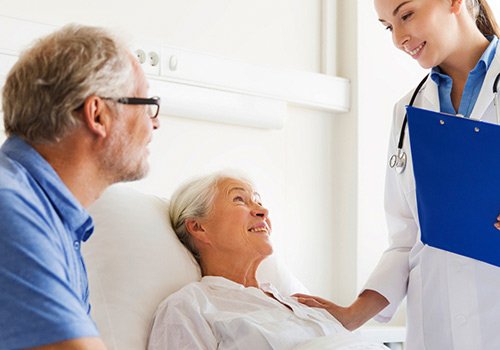Gall Bladder Disease
The Condition
Description
Gallbladder disease is an umbrella term for several conditions affecting the gallbladder. Inflammation of the gallbladder wall (cholecystitis) is responsible for a majority of the gallbladder diseases. Diseases of the gallbladder include gallstones, gallbladder polyps, gallbladder cancer, and sclerosing cholangitis.
Causes
Most cases of cholecystitis are associated with the presence of stones in the gallbladder. Usually, gallstones do not cause any problem or symptoms, but may sometimes block the bile duct, trapping the bile in the gallbladder. The trapped bile causes inflammation of the walls of the gallbladder, leading to swelling and pain. The inflamed gallbladder may also become infected.
Rarely, cholecystitis occurs without the presence of gallstones. This type of acute cholecystitis is referred to as a calculous cholecystitis. It is a more serious form of cholecystitis and tends to occur with gallbladder injury during surgery, prolonged fasting, critical illnesses or when a problem with the immune system occurs.
Impact
Gallbladder diseases can impact your health significantly by causing severe abdominal pain and decreased quality of life.
Anatomy
The gallbladder is a hollow pear-shaped organ that lies just below the liver. Its primary function is to store bile, a thick yellow-green liquid produced in the liver. Bile aids in the digestion of fatty foods. Stored bile drains out from the gallbladder into the common bile duct, which opens into the small intestine.
Symptoms
Gallbladder disease leads to severe abdominal pain. The pain is felt on the right side of the upper abdomen, and may travel to the back or right shoulder. Other symptoms may include nausea, vomiting and fever.
Diagnosis
Problems with the gallbladder are diagnosed by reviewing your medical history and performing a thorough physical examination. Your doctor may recommend X-ray imaging, abdominal ultrasound or nuclear scanning tests to detect the presence of gallstones which may be blocking the path of bile and thickening the gallbladder wall. Blood tests may be ordered to check for signs of infection, obstruction and jaundice.
Treatments
Treatments depend on the type of gallbladder disease. The first line treatment for most gallbladder diseases includes antibiotics. In cases of small and unclarified gallstones, certain medications can be prescribed to dissolve them. Lithotripsy (use of shock waves) is another non-invasive procedure that can be used to crush the gallstones, where the fragments of the stones are flushed out through the urine.
When you experience multiple gallbladder episodes, a surgery called cholecystectomy is most often recommended. The surgery can be performed through a less invasive approach or the traditional open surgery to remove the gallbladder.
Prognosis
Fortunately, the gallbladder is an organ you can live without. Gallbladder removal most often results in complete recovery and does not require a specific diet after the surgery.
Untreated gallbladder disease
If left untreated, the gallbladder becomes severely infected, causing some of the tissue to die and decay resulting in septicaemia (blood poisoning), a life threatening condition. In some cases, the gallbladder may even burst or an abnormal channel may develop between the gallbladder and gut due to the inflammation.
Surgical treatment
Surgery
Gallbladder surgery is considered the standard of care for gallbladder disease treatment. Cholecystectomy surgery involves the removal of the gallbladder and is usually performed through laparoscopy, a minimally invasive option as compared to open abdominal surgery which requires a long incision. In cases where gallstones are present inside the bile ducts, endoscopic retrograde cholangiopancreatography (ERCP) technique can be used during gallbladder surgery.
Procedure
Cholecystectomy
Gallbladder surgery can be performed through a minimally invasive approach where your surgeon makes several small incisions in your abdomen. Through one of the incisions a laparoscope, a small fibre-optic tube with a tiny camera, is inserted. Through this approach, your surgeon will be able to view the surgery on a large screen. Cholangiography (X-ray of the bile duct) is performed to view the bile duct for any abnormalities. Special surgical instruments are inserted through the other incisions to remove the gallbladder. If your surgeon finds stones in the bile duct, they can also be removed.
If tests show the gallbladder has severe inflammation, infection or scarring from other operations, the surgeon may perform open surgery to remove the gallbladder. In some cases, open surgery is planned; however, sometimes these problems are discovered during the laparoscopic procedure and the surgeon must make a larger incision in order to convert to open surgery.
Endoscopic retrograde cholangiopancreatography (ERCP)
Endoscopic retrograde cholangiopancreatography (ERCP) is a procedure performed to remove gallstones blocking the bile ducts. The ERCP technique involves swallowing a long, flexible tube with a light source and camera called an endoscope, which helps your surgeon view the operating site on a monitor. The endoscope reaches the small intestine through the stomach and the affected duct is located by releasing a special dye. Your surgeon cuts the affected duct with tiny instruments passed through the endoscope, and captures the gallstones in a mesh basket, which is then removed along with the endoscope.
Post–operative information
Following the procedure, you may be discharged the same day if you have undergone a laparoscopic procedure, or within 2 to 7 days in the case of an open procedure. Inform your doctor immediately if you experience high fever, chills, severe pain, stomach cramps, vomiting, yellowish skin, increased drainage from the site of incision and no bowel movements for three days.
Benefits of this approach
Laparoscopic surgery requires minimal recovery time, shorter hospital stay, and you will experience less pain and discomfort after surgery, unlike traditional open surgery, which requires a longer hospital stay, recovery time and longer time to operate, and involves a larger scar.
Preparation
You may be instructed not to eat or drink anything at least six hours before the procedure in order to keep your stomach empty. Your surgeon will review your daily medications, and may suggest those that you can take with a sip of water. You will be instructed on the medications that you need to avoid.
Outcome
Laparoscopic cholecystectomy is a safe procedure that provides relief to symptoms of gallbladder disease. However, as with any procedure, cholecystectomy may involve certain risks and complications such as bleeding, blood clots, wound infection, or injury to the bile duct, intestine and blood vessels.
Post-op stages of recovery and care plan
After the procedure, you will be given specific instructions with regard to your diet. You are instructed to eat high fibre foods and drink 8 to 10 glasses of water per day to avoid problems related with bowel movements. To relieve pain, you will be given pain relieving medications after surgery.
Care should be taken while dealing with your wound. Remember to wash your hands before touching the dressing, and avoid soaking in the bathtub until your stitches are removed. Wearing tight fitting clothes is not recommended as they may rub against your incisions and interfere with the healing process. In about 4 to 6 weeks, your scars will become soft and gradually fade.
Down-time lifestyle or off- work duration
You can gradually resume your daily activities after the surgery. This normally takes around 2 to 3 weeks. To reduce the risks of blood clots, you are encouraged to start walking as early as possible. You can return to work 1 week after the surgery. However, if your work requires lifting heavy objects, you can resume these activities only after 4 to 6 weeks.
Costs
Any costs involved will be discussed with you prior to your surgery.




















